|
|
![]()
FOREST HEALTH - INSECT PARASITES AND PREDATORS
Parasites
Parasites are insects that live in or on other insects and feed off a particular host individual. Brachionid and Ichneumonid wasps have long, scary-looking ovipositors but are harmless to humans. The females use these long ovipositors to drill through wood and deposit eggs into the larvae of wood borer and other larvae. The eggs hatch and the wasp larvae use the living host as a source of food. Friendly flies from several genera lay eggs in various species of caterpillars, using the caterpillars as food for the newly hatched young. There is a particular species of friendly fly which now helps check the damaging outbreaks of the exotic European gypsy moth. Hyperparasitism is when one insect parasitises another insect parasite.
Predators
Predators move around freely and eat as much prey as needed in order to complete their life cycle. Beetles are the most important of the insect predators, such as checkered beetles, ground beetles, and ladybird beetles. Ants eat many tree-feeding larvae. Of course, some ant species will also husband aphids for the production of honeydew. Many other insects are predators of insects, such as adult lacewings on aphids, and dragon/damsel flies, antlions, certain wasps, certain true bugs, and mantids.
Non-insect Parasites and Predators
Of course, there are many non-insect taxa that feed on forest pests, such as birds, fungi, mammals, and many others. These are all important in the food webs and controlling insect outbreaks. However, review of these other taxa are not part of this website, but there's a lot of really interesting examples to be learned about.
Biological Control Agents |
Friendly Flies Lacewings Mantids Wasps |
|
Biological Control Agents (insects, fungi, bacteria): Fighting infestations with introduced (or native) species of insects and diseases is one tool in the arsenal against harmful epidemics and invasions. Natural control mechanisms (or doing nothing) are usually the best 'action' against native outbreaks, even when high populations cause human inconvenience. Exotic species are a different story. Sometimes, parasites and/or predators can be found that are specific to an exotic species or genus. A good example is an Entomaphaga fungus against gypsy moths (second image). As moth populations build, the Entomaphaga fungus follow. With cooler and moister spring weather, the fungus gains the upper hand. With warmer and drier springs, the advantage goes to the gypsy moths. Another good example is the bacterium commonly called 'BT'. It can be sprayed locally or broadly, and kills moth and butterfly larvae. As for insects, there have been parasites/predators for purple loosestrife, spotted knapweed, et al. Sometimes, public agencies incorrectly receive credit (or blame) for introducing control agents, such as the friendly fly populations that build following forest tent caterpillar outbreaks, or the Asian ladybird beetle migrations. Soon, scientists may have a wasp parasite than might help control the spread of the emerald ash borer. |
||
| Hosts: specific insect taxa, sometimes single species | ||
 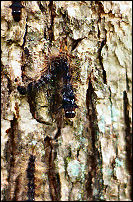 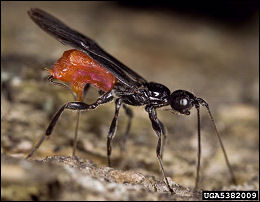 [armed cerambycid, Entomphaga-killed gypsy moth, Braconid wasp on emerald ash borer] |
||
Ants (Formicidae family): voracious predators of aphids and other small insects, although some ants 'husband' aphids for their honeydew and fiercely defend aphid colonies against predators, carpenter ants don't harm trees but they excavate wood softened by rot fungi |
||
| Hosts: just about any soft-bodied insect | ||
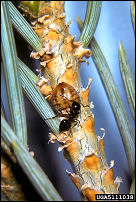 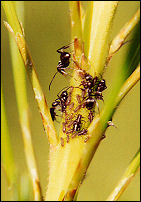 [ant on scales, ants nursing aphids, large ant mound] |
||
Beetles (several beetle families): most aggressive of insect predators, the tiger beetle (first image) is sometimes mistaken for the emerald ash borer |
||
| Hosts: wide range of insect prey | ||
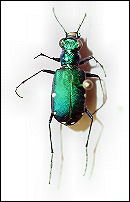 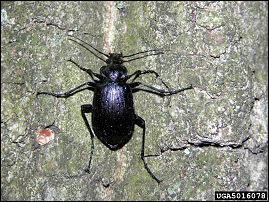 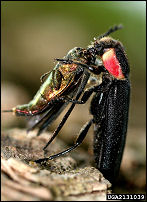 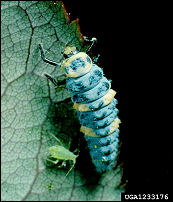 [common tiger beetle, Carabid beetle, checked beetle feeding on EAB, Asian ladybird beetle larva] |
||
Bugs (Hemiptera order): a group of true bugs with sucking mouth parts that pierce prey to feed on body juices, assasin bugs, wheel bugs |
||
| Hosts: wide range of insect prey | ||
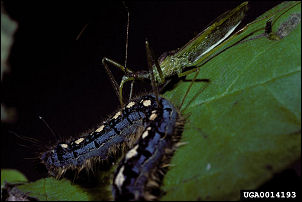 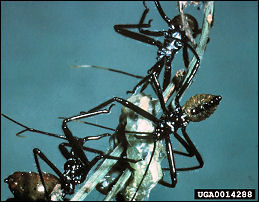 [assassin bug on forest tent caterpillar, wheel bugs on a caterpillar, common fall assassin bug in the U.P.] |
||
Dragon & Damsel Flies (Odonata order): nymphs are aquatic, adults feed on many small insects, dragon flies sit with wing horizontal, damsel flies sit with wings vertical |
||
| Hosts: almost anything they can catch | ||
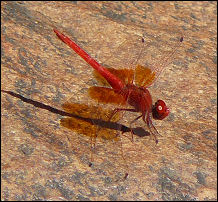 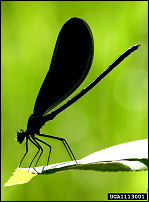 [dragon fly, damsel fly] |
||
Friendly Flies (Diptera order, familes Syrphidae, Tachinidae & Sarcophagidae): some species eat prey, other species parasitise prey, caterpillars are favorite prey/hosts |
||
| Hosts: small insect larvae, aphids, plant lice, some are species-specific | ||
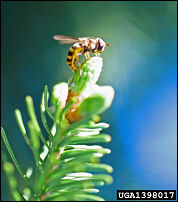 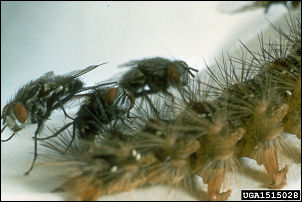 [Syphid fly, Tachinid fly] |
||
Lacewings (Neuroptera order, Chrysopidae family): larvae typically predatory, common but do not have much of a control effect on forest damaging insects |
||
| Hosts: small soft-bodied insects, aphids, plant lice | ||
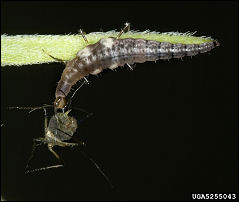 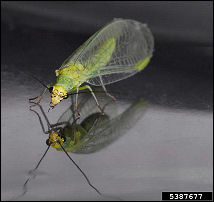 |
||
Mantids (Orthoptera order, Mantidae family): not a significant control of tree-feeding insects, rather spectacular insects |
||
| Hosts: just about anything they can catch | ||
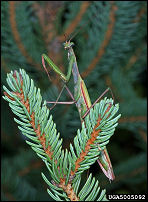 |
||
Wasps (Hymentoptera order, several families): some species are predators, other species are parasitic, most do not sting humans (but some do!) |
||
| Hosts: moth & butterfly larvae are favorites, sometimes other taxa, some are genus/species specific | ||
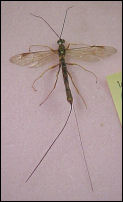 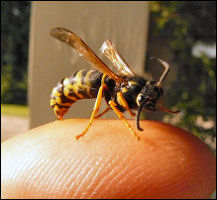  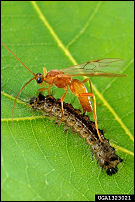 [Ichneumonid wasp, yellow jacket, hornet nest, Braconid wasp] |
||
Image Citations
Biological Control, Wasp (3) - David Cappaert, Michigan State University, Bugwood.org
Ants (1) - United States National Collection of Scale Insects Photographs Archive, USDA Agricultural Research Service, Bugwood.org
Beetles, Carabid (2) - Pennsylvania Department of Conservation and Natural Resources - Forestry Archive, Bugwood.org
Beetles, Checkered (3) - David Cappaert, Michigan State University, Bugwood.org
Beetles, Asian Ladybird (4) - Clemson University - USDA Cooperative Extension Slide Series, Bugwood.org
Bugs (1) - Assasin Bug - Gerald J. Lenhard, Louiana State Univ, Bugwood.org
Bugs (2) - Wheel Bug - Gerald J. Lenhard, Louiana State Univ, Bugwood.org
Damselfly (2) - David Cappaert, Michigan State University, Bugwood.org
Flies, Syrphid (1)- Steven Katovich, USDA Forest Service, Bugwood.org
Flies, Tachinid (2) - USDA Forest Service - Region 8 Archive, USDA Forest Service, Bugwood.org
Lacewing Larva (1) - David Cappaert, Michigan State University, Bugwood.org
Lacewing Adult (2) - Joseph Berger, Bugwood.org
Mantid (1) - David Cappaert, Michigan State University, Bugwood.org
Wasp, Brachonid (4) - Scott Bauer, USDA Agricultural Research Service, Bugwood.org
All others - Bill Cook, Michigan State University Extension
Click HERE
to return to the U.P. Tree ID home page.
Click HERE to return to the Forest Health home page.
This site created and maintained by Bill Cook, MSU Extension Forester for the Upper Peninsula of Michigan. Editing and modification is ongoing. Submit suggestions, questions, and corrections to cookwi@msu.edu or call 906-786-1575.